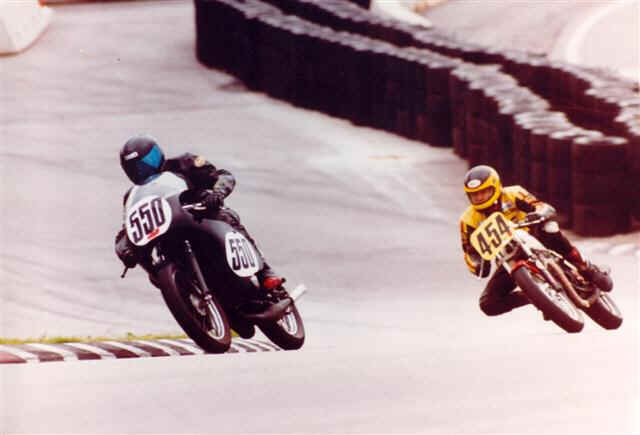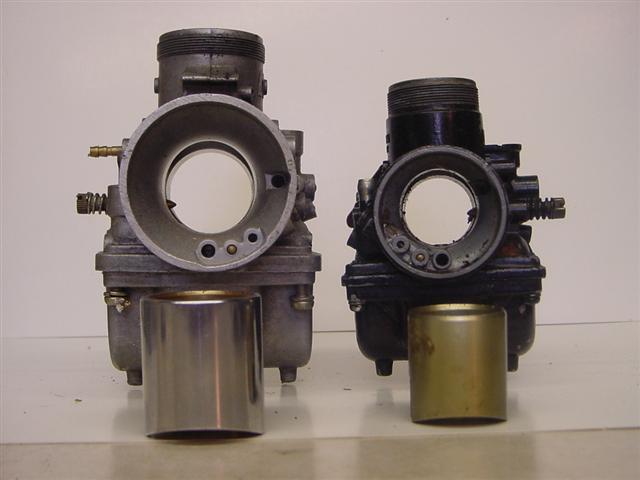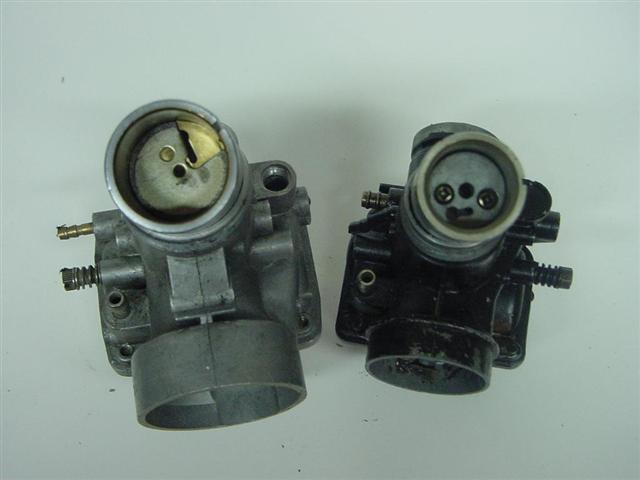

Pete and Todd Henning, the master of vintage racing in the '90's, at NHIS.
© Geoff Battick
First, you need a set of expansion chambers. This is the first performance boost anyone should make. There are still several companies making them, and a few new guys have come and gone.
Pipes are a funny subject.. They really define the way the power " feels " to the rider. Of course, they make a very important contribution to power output, as well. If you study pipe design, you will learn that a pipe is really optimised to one very defined set of engine parameters.
What this means is that your off the shelf pipe will work pretty damn well with about any engine config, but to be the best it can be it needs to be used with cylinders/heads like it was designed with. What can the average guy do about that? Not much. If you want to get really into it you can buy software that will design a pipe to match your engines specs, then you will have what the GP boys get, a "custom" pipe. Then get a sheet metal guy to cut and roll the parts you need and weld it up so it does not drag on the ground when you lean the bike over and toss you into the weeds.
That's the ultimate way to go. But if you are a regular kinda person, you'll buy a set from a reputable manufacturer. I have used Spec II pipes and a set of prototype pipes from Harry Barlow that are now a few years old. We started with the SpecII's, and went to the Barlows' in search of more power. Couldn't really tell a difference in power (we never did dyno them), and the laptimes did not improve. The newer Barlow pipes, if you can get them, are undoubtedly improved, but I have no first hand experience with them.
WEBMASTERS NOTE I have tried Harry's pipes with both engines he has tuned for me and my own self tuned engines and they work VERY well :}
MotoCarrera builds what I call race pipes as well. Toomeys work real well, but they are hard to find, being out of production for many years now. I do not consider DG or the old Bassani's to be " race " pipes. They are heavy, and of a simple design, a good replacement for a street bike, but I have never seen any win a race. The guys I know here on the East Coast that win races are using SpecII and Toomey and Motto Carrera
CARBS : I'll admit it, I've never built a race motor for myself that ran stock carbs. Formula RD was not yet here when I started racing, and the classes we ran allowed any size round slide carb you wished to use. For the street, I used re-jetted stockers with K&N's and later a set of SpecII 30's with BIG Uni's. The bigger carbs are worth the price just in ease of tuning alone. Main jets are equally simple on both but the needles are so much easier on the 30's it's not funny. F-RD guys must get frustrated wrestling with those slides while the more modded bike tuners can change needle settings in about three minutes.
Some people complain of a flat spot at 4k or something like that with the 28's and K&N's, but I never have really noticed it, but then again if you want to ride around at 4000 rpm all day why ride an RD? I always just roll the throttle on at those low revs until the engine gets closer to the powerband. Problem solved in my book. That is how you really want to use the throttle if you want to be fast, even on the track. Bigger carbs can mean bigger power, up to a point!
We settled on Mikuni VM34's. Easy to tune, great response, and great ridability. The reed valve RD is forgiving on throttle bore size, so it is possible to use bigger carbs and have the bike still run, but I think the powerband will start to suffer. Velocity of the airflow through the carb is everything. Too big and the airflow gets real sluggish so throttle response gets poor and it's harder to jet correctly. So avoid the temptation, as strong as it is, to go the He-Man route and jam some '38s into your stock inlet manifolds. You'll be faster with a more conservative approach.
As a little test one spring I dyno'ed our RD after Daytona, where my rider had insisted on using a set of 38's after speaking with a friend of ours who used to race TZ's and TR's way back when. I must tell you that we were using TR3 cylinders at the time, which are piston-port, not reed valve, so there is no low end power to speak of. I thought the 34's would have been easier to ride and therefore faster, even at Daytona.
The rider felt the bigger carbs were faster. So we strapped the bike down and did a few pulls. The bigger carbs helped the engine pull higher revs than it had with the 34's, as had been reported by the rider. It made 58hp @ 10500 rpm. Then the 34's went on. The result was 61hp @ 9500 rpm. The big carbs felt faster than the old setup because they made a bigger " hit " when they finally started to work as compared to when they were running poorly, and the resulting narrower powerband felt more frantic.
If you compare the BMEP figures you'll see the 34's made 118psi vs. 101psi for the 38's. Definite detuned. So we had traded a bunch of driveability for a few more MPH at redline. We still finished sixth out of thirty two entrants, but we had hoped for more. So you can see I do not like wild carb sizes. Use 28 to 34's and jet them correctly.
I will not offer any magic jet combos, as your individual engine configuration and riding style have a huge influence. Well, OK, I will give you one setup for 34's that works well for us. here it is:
main jet: 260-280
N. jet : 159 P-8
needle : 6F9
pilot : 45
slide : 2.5
air jet : 2.0
Like I said, this is only one of many combinations that might work but it is a good starting point for anybody who is adapting a set of 34's from another bike or something like that. Once I got my motors set up early in the season, they rarely needed much jet fiddling. This is mostly due to the head design, which really keeps detonation and excess heat out of the pistons. When we raced at NHIS, or Loudon, for the old timers among us, it was very common to have first practice in 60degs with a light fog just burning off and by the time the races started later that day it would be 78degs and bright sun. I would just richen the main jet first thing in the morning and reduce the same jet in the afternoon, watching the plugs and listening to how Pete felt the engine was pulling.
You should check the slides to make sure they are in synch at the start of every race weekend too. They need to open at the same time with no lag between one or the other, and both open fully as well. Be sure to secure the throttle cables to the carb tops! A cable that slips out and hangs up on the adjuster will not allow your engine to return to idle when you shut the throttle. That is no fun if it happens as you are braking for a slow corner after a fast section of track.
I also suggest the use of inline fuel filters, the biggest ones you can fit in the space given. Crud from the tank can cause problems like sticking fuel needles that then cause flooding or worse, and I have seen jets plugged as well, which in the worst case can lean the mixture out enough to cause an engine seizure.
One of those handy Mikuni Jetting slide rules is great to have in your toolbox to help with this when you are beginning to do this yourself. Plug heat range is a factor here too, and I'll discuss that in more depth elsewhere.
This chart shows how the circuits relate to the throttle position. Don't be a total newbie and just think that by changing the main jet you will fix the problem.
An excellent book on carb tuning is the Carb Tuning Handbook by Olav Aaen. It is available from AAEN Performance and most Mikuni distributors. Being a high performance snowmobile guy, his book deals only with two-stroke set ups, so you do not have to bother skipping chapters on setting up your Weber or Bing carb.
Remember when it comes to jetting....always start rich and work down from there. Yes, it might take a little time at first to get in the range your bike really responds to but it will not hurt your engine. Be sure to use a large pilot jet size like in the specs above. Too small and you can have a closed throttle seizure as you run into a turn or down a hill. That was quite common at NHIS for the beginners with street sized pilot jets.
We're not after a nice idle for city street stoplights here, we want good off idle response and enough fuel at all times to keep heat at bay. Air cooled two stroke motors are liquid cooled too, but it's the fuel, not water and a radiator that do that job.

VM34 Mikuni carb vs. 28mm stock RD carb. The bore size difference is huge. The slides in front of the carbs also give you an indication of the size difference. The 34's have a choke, which is actually an enriching circuit, on each carb instead of the one choke with a connecting tube between the two carbs like the stock carbs do.
This means you need to flip a lever on each carb for cold starts. Aftermarket kits usually supply one of the two carbs with a bent lever which allows for easy manipulation. I adapted a choke cable from a dual carb snowmobile that gave us one lever to control both carbs, mounted on the bar or frame within real easy reach of the rider.

Here you can see the tops of the slides. To change the needle position on the 34's you simply unscrew the top, lift the spring and remove the plate inside the top of the slide. Move the needle clip, drop the needle back in its hole, replace the plate, put the spring back in the slide and screw on the top. Done. In the 28's you unscrew the top, lift the spring and while juggling that unscrew the two screws that hold the needle retainer in place. Then once that is removed you can change the clip. reassembly, as they say, is the reverse of disassembly. Takes four times as long, at least, on the 28's. If you have to use stock carbs because of class rules, get good at this little chore.

|
 |
|
|
|